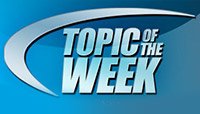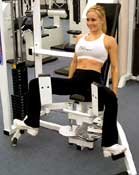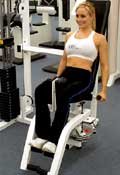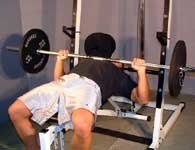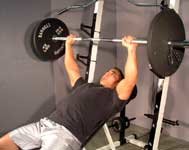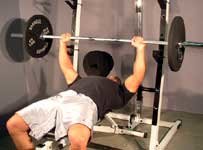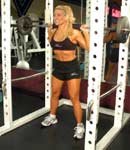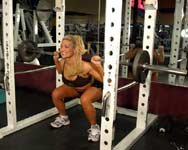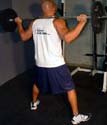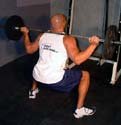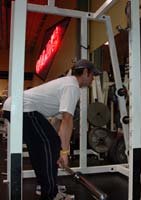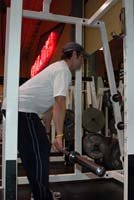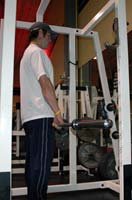
TOPIC: What Is The Significance Of The Big 3?

The Question:
Most bodybuilders don't brag about how much they curl, or what they do on the tricep machine. Bodybuilders are discussing the big 3 lifts:
- Squats
- Deadlifts
- Bench Press
The big 3 seem to have more attention than any of the other exercises. Why are the big 3 so popular?
What sort of effect do the big 3 have on a bodybuilder's physique? How should the big 3 be incorporated into a bodybuilder's workout?
Can the big 3 be used solely on their own for a great workout routine?
Bonus Question: Which exercises (if any) are better and/or more effective than the big 3? Why? Would you rather do the big 3 or bodyweight exercises? Why?
Show off your knowledge to the world!
The Winners:
- perldog007 View Profile
- DSM18 View Profile
- Squats View Profile
Prizes:
- 1st place - 75 in store credit.
- 2nd place - 50 in store credit.
- 3rd place - 25 in store credit.

1st Place - perldog007

Most bodybuilders don't brag about how much they curl, or what they do on the tricep machine. Bodybuilders are discussing the big 3 lifts:
- Squats
- Deadlifts
- Bench Press
The big 3 seem to have more attention than any of the other exercises.

Why Are The Big 3 So Popular?
No simple answer readily presents itself that adequately addresses this issue. We could just say that Arnold is one of the most popular bodybuilders of all time and he endorses these movements.
If he ever wrote a vegan cookbook, Arnold would find a way to include the squat, deadlift and bench press somewhere around the baking section.
We could further state that if the word of the Governor of the Great State of California isn't good enough for you, then you are cordially invited to:
- Take your unpatriotic butt to the nearest hippie fried commune.
- Drive your estrogen levels through the roof according to your preferred method.
- Leave the commune only for Pilate's class.
- Watch endless re-runs of "Three's Company".
While the above answer certainly suits me it does not really begin to probe the depth and complexity of this subject.
In his updated Encyclopedia of Modern Bodybuilding Arnold also confesses to beginning as a powerlifter and said it gave him the "thickness". His classic work also references scientific studies proving that compound movements with free weights increase testosterone.
Another great man in the iron game is Dr. Squat. Fred Hatfield, PhD. He is one of the best writers of all time on the subject of weightlifting. Dr. Squat tells it like it is and he tells us that compound movements with free weights increase muscle mass.
A ten thousand character post can't cover all the reasons for the popularity of the big three in bodybuilding. Let's focus on some functional points for the purpose of our discussion.
They are:
- Testosterone.
- Ego (and Testosterone)
- Muscle Mass (and Testosterone)
- Core Strength (and Testosterone)
- Enhanced Balance and Stability (and Testosterone)
 Testosterone:
Testosterone:
- The top of our list may very well be the list for many. Testosterone is the name of the game in bodybuilding. The male hormone that makes muscles grow and libidos' rage.
The big three when performed with copious amounts of free weight will cause the body to increase production of testosterone. This in turn gives the athlete strength, aggressiveness, confidence, and muscle growth. All good things in bodybuilding.
 Ego:
Ego:
- A spin off of Testosterone production and valuable cohort to it is ego boost. We can lift more weight in a deadlift than in a lateral side raise. There is something visceral about lifting more than your own weight.
Any one of the big three may get you there. The sense of accomplishment along with the hormonal boost is also good for the ego. A healthy ego is key for any competitor perhaps even more so in the nerve wracking mind game of professional bodybuilding.
 Muscle Mass:
Muscle Mass:
- Using all those muscles in a compound movement and increased testosterone will result in more muscle mass. This is key in bodybuilding. Definition is great, but everybody wants big, and that means increased muscle mass. The big three does this for us in a way that nothing else quite matches.
 Core Strength:
Core Strength:
- The big three, especially the squat and deadlift increase core strength. Having strong back and abdominal muscles have benefits that go far beyond posing.
When the core muscles of the body are stronger, so is the whole body. Everything you do is enhanced and the prospects for aging gracefully increase dramatically if you have and maintain a strong core. Of course, the testosterone helps here too.
 Enhanced Balance & Stability:
Enhanced Balance & Stability:
- All that testosterone and hard work will also build the stabilizer muscles we use with free weights. The exercise itself and extra confidence from the testosterone will enhance our balance.
Strong stabilizer muscles and improved balance again provide benefits far beyond the posing stage. Speaking of the stage, good balance and enhanced stabilizers won't hurt you on stage one bit.
 Spotters:
Spotters:
- Most bodybuilders wisely enlist training partners as spotters for these lifts. This scenario provides camaraderie and support. Working with other athletes gives us a chance to give and receive feedback and exchange ideas. The sort of thing that usually doesn't occur on the thigh adduction machine.

What Effect Do The Big 3 Have On Physique?
Excellent! I get to talk old school. Let's look back to the day.
Angelo Siciliano, a.k.a. Charles Atlas built his physique mainly with isolation exercises using his dynamic tension method according to a Federal Trade Commission finding of fact. Contrast his build with a young Arnold, circa 1965.
At the risk of being repetitive, young Arnold has a lot more muscle mass than the young Siciliano.
Am I the only one who noticed that Bolo Yeung looked better in 1986 at age 48 in Bloodsport than he did in 1973 in Enter the Dragon? Born in 1938 and still sporting a physique that most of us would kill for, this man has done his homework with the barbell and classic big three.
If Mr. Yeung ever gets below 6% body fat he could probably win the pose down in the master's class and the bar fight at the after party. That would be any master's class and any after party.
In summation, performing the big three consistently has the effect of imposing the freaky deaky "thickness" mass gain on the physique of the bodybuilder wise enough to employ them.

How Should The Big 3 Be Incorporated?
Perhaps the Bodybuilding.com T-shirt covers this one best - "Eat, Sleep, Lift, repeat".
You should get these important exercises into your routine any way you can. A bodybuilder could certainly exercise every muscle group without the big three, but why? Sometimes bucking tradition for the sheer hell of it just doesn't pay.
These fundamentals should appear in your regular routine, and in different variations. For example:
- Hack Squat
- Romanian Deadlift
- Incline Bench Press
- Wide-grip Bench Press
You get the idea.
Also, many find it beneficial to work a day of power lifting using a basic exercise into their bodybuilding routine. Still another approach is to abandon your regular split for a specified time and concentrate on the big three. This can spice up a good bulk for some.
Can the big 3 be used solely on their own for a great workout routine?
Unquestionably yes. Of course it will be beneficial to the bodybuilder to "cycle" through a workout like this and at some point return to a split with more specialized isolation exercises. For other athletes, this may be a great routine as a staple.

Bonus Question:
Which Exercises (If Any) Are Better And/Or More Effective Than The Big 3? Why?
For bodybuilding? None.
Why? Because if there were, Dr. Squat and Arnold would have advised us. If this were a forum discussion on kickyourbutt.com and not Bodybuilding.com an argument could be made for the clean and jerk and the snatch. But it ain't! In this ring, the big three K.O.'s all the competition.
Would You Rather Do The Big 3 Or Bodyweight Exercises? Why?
Another easy one - the big three all day. Bodyweight exercises have many advantages but they don't spur testosterone production like the big three. Testosterone is so important that some ruin their health or get locked up trying to add some to their bodies. All us mortals have to do is squat, deadlift, and bench press for it. Well... sign me up!
Thanks for reading, lift safely and lift well.

2nd Place - DSM18

The "Big 3" - Squats, Deadlifts and the Bench Press, are often neglected by trainers quite simply due to their difficulty, but if you are willing to leave your heart at the squat rack and give these exercises your every last bit of energy, then the results you will get will improve both your physical and emotional conditioning and strength like nothing before.
 Muscle Growth:
Muscle Growth:
- These three exercises are known to stimulate muscle growth, and are used primarily by professional powerlifters as a means of gaining superhuman strength.
 Hormone Levels:
Hormone Levels:
- Results have also shown that by performing these big, multiple joint movements, levels of hormones that are responsible for muscular hypertrophy are secreted at levels that far surpass that of conventional, isolation movements. And this all leads to a bigger, stronger body you've always dreamed of.
 Ego:
Ego:
- By recruiting stabilizers, these compound movements will contribute to more of a masculine, Herculean look that machines are unable to achieve. Additionally, they allow you to carry incredible amounts of weight that not only satisfy even the most tender ego's, but are one of the many reasons they are ideal for adding muscular mass.
 Beginners & Hard Gainers:
Beginners & Hard Gainers:
- This applies particularly for both beginners and hard gainers. Most beginners need to establish good habits to take them into their later stages of training, and from those I know who started training without avoidance of training principles that are often feared, such as not avoiding more taxing exercises like the deadlift, have to this day. They have kept marching on to continued progress.
I see many hard gainers who believe that their genetic inferiority means that they will never have the body they want. I have three words for these people - Squat, Deadlift, Bench Press.
I have a friend who started out at 130lbs, and packed on 50lbs of mass from simply prioritizing compound movements such as the "big 3". The only reason anyone isn't getting bigger, is because they aren't training smartly.

Where In Our Routines Do These Exercises Fit?
Compound movements such as the big 3 should always form the core of your routine, around which a degree of isolation exercises can be added.
The ratio of compound to isolation movements should be at least 1-1 or more for any routine, regardless of your goals. Compound movements hit your muscle as a whole, and thus are ideal to use as a core to each body part routine. They also allow for your body to work as one, the way nature intended.
So where do squats, bench press and deadlift fit into a workout routine? First, due to their high intense nature, they should be prioritized at the start of your workouts to ensure you are at your highest energy when performing them.
These exercises respond to pyramiding the weight up on each set, so it's smart to also lower reps slightly on each successive set. They also respond to a high number of sets, particular if strength is your aim.
 Bench Press:
Bench Press:
- First, with chest; bench press should be complemented with an incline pressing movement such as incline bench for a more balanced chest which will avoid a sagging chest that is common with those who perform only flat and decline presses. Additionally, dumbbell flyes can be used as a free-weight complimentary exercise.
 Squats:
Squats:
- What about squats? They can either be performed at the beginning of a leg workout, followed by leg presses, or like a lot of people do, performed after several sets of leg extensions which serve to pre-fatigue the quads using a less taxing isolation movement, then when you hit the quads with squats, you will really feel it.
I recommend 5 sets of squats, making sure you start with a light warm up set or two before going down to 6 reps on your last set. Remember, squats are like any other exercise, so both high and low reps shouldn't be ignored.
 Deadlift:
Deadlift:
- Now, for probably the most feared exercise in existence, the Deadlift. Like the other 2, it should be prioritized at the start of a workout. Here, I recommend 3-5 sets, and go heavy... or go home!

My Favorite Tips For Each Exercise
& Correct Form
 Bench Press:
Bench Press:
- Lie on the bench, making sure you have a natural, slight arch in your lower back, and maintain this during the movement. Grab the bar at just wider than shoulder width.
As you lower the bar, keep your elbows out, lower it in a controlled manner to just above the nipple line, then press the weight up, ensuring it is traveling in a straight line. Avoid resting at the top of the movement to maintain tension on the pecs.
- Pause for one second at the bottom of the movement, and contract your chest. This ensures you are going deep and especially ensures you are not using momentum to get the weight up.
You will also feel a nice stretch. "Stretch" exercises such as donkey calf raises, and performing the bench press in this manner can trigger the body into more anabolic hormone release as the body reacts with an emergency response to the stretch which causes more fibers to fire.
- Lowering the weight to certain areas of your chest can emphasize more on particular regions. Lower the bar higher on your chest will recruit more of the upper chest, and the lower your raise the bar, the more on the lower chest it will target.
- Grip width also has a similar affect. The wider the grip, the more outer chest will be recruited, as opposed to going closer which will hit more of the inner chest, but at the expense of also hitting triceps.
 Squats:
Squats:
- Start by making sure you are looking forward during the entire movement which keeps your body aligned. Keep your chest out and your torso erect too.
Place the bar on the traps, rather than the neck which takes pressure of the cervical spine and keeps the body better aligned. Start your descent by thrusting your buttocks backwards, which prevents you from leaning too far forward. Come up by driving the hips back in and up.
- Make the most out of different foot stances as each will emphasize on a different area of your quads. For that famous outer sweep, keep feet close and pointing forward.
The wider your position your feet, the more of the inner quads are recruited, and standing very wide, also known as "sumo" squatting will recruit the adductor muscles on the inner thigh. You will most likely find that the wider the foot stance, the more you are able to lift.
- A lot of people either don't know this, or forget, but what area of your feet you press from can have a significant affect as to whether you are actually hitting your quads.
If you press off your heels, you will recruit the gluteus maximus, and to an extent the hamstrings at the expense of the quads. Pressing off forefoot on the other hand will recruit more of the quad muscle.
 Deadlifts:
Deadlifts:
- Position your feet shoulder width apart, feet planted firmly on the ground with a bend in the knees. Grasp the bar with a medium grip. As you lift the bar, ensure it travels in a horizontal plane, and keep it close to the body. Maintain a very slight arch in your lower back, and never round your back which can potentially cause serious back injury.
Go as deep as you can on descent, and on the ascent, bring your back up to its starting position, but don't go past parallel here. If you are looking for a full range of motion in an extension-based exercise, do hyperextension as well and contract 20-30 % past parallel. Remember to use your legs during the deadlift to maximize poundage.
- Sumo-style deadlifting (a wide-stance) is a variation of choice by many professional powerlifters as the stance recruits the leg muscles which will enable you lift more. Add in one set with this stance for variety.
- If you are short, you might find that the weight plates hit the floor before you are able to achieve a full range of motion. If this is case, there a few options. You can simply exchange the 45lb plates with 20lbs on each side which give you more room, or alternatively, you can deadlift elevated on a platform.
- The power-rack can do wonders at improving your deadlifting, and is especially useful if you are competing. Here, by setting two pins within a distance of several inches and placing a bar in between, you are able to stack on almost twice the weight - just hold the weight for a count of 10.
Alternatively, you can hold the bar in a length-wide position, i.e. the bottom of the rep, for as long you can. Both are temporary alternatives, and when you return to regular deadlifting, you'll be amazed at your strength gains.

How Do The Big 3 Compare To Other Exercises?
Nothing compares to the Big 3 when trying to add pure muscle mass, or gain strength. There are no other exercises that will give you better results in these areas than the big 3. There are alternatives to the above exercises, such as body weight squats, or using a smith machine, but the result will be far inferior to what the real variations will bring.
A thing to remember is the key to any balance routine and that is, of course, balance. Both big compound movements, and isolation exercises have their own purpose, and the best thing to do is find a balance according to your own fitness goals.
These 3 exercises - the squat, bench press and deadLift, should form the basis to any routine, and if used consistently will give you the results you've always wanted. The exercises are there, it's up to you to get off your @ss and do them!

3rd Place - Squats
What Is The Significance Of The Big 3?
 The Bench Press:
The Bench Press:- From a bodybuilder's standpoint on the big-three is that the bench press is virtually useless to them. They mainly abandoned it and left it to the powerlifters now. I have heard about 5 or so stories about guy's tearing their pecs because of bench pressing. And many feel that the bench press is only working their delts and triceps more then chest.
Many feel this way, some don't... we're all different. But the majority of the people have not used the bench press in a while with a regular barbell and flat bench. They have looked towards different angles and dumbbell and some with machines.
 The Squat:
The Squat:- The squat is still very alive with bodybuilders today, the big thing now is to always go @ss to grass. Which I personally like to call @ss over tin cups.
 The Deadlift:
The Deadlift:- The deadlift is another exercise bodybuilders still use; thickens the upper body and improves musculature in the hips as well. I believe any bodybuilder's program in training should include these three lifts, but not as high rep sets or anything like that, but heavy and hard.

Powerlifting & Bodybuilding
Powerlift using the 3 lifts and body build using other exercises. I have done powerlifting, bodybuilding, powerbuilding, etc. for a while. When I started out I always trained heavy with the three main lifts and normally did other lifts 8-10 reps other than certain compound movements. That way I could get strong and improve my physique at the same time.
 Muscle Growth:
Muscle Growth:- Lifting heavy on the three big lifts will make muscle grow. I know a lot of bodybuilder's out there today who believe that lifting heavy will not build muscle.
But I have also noted that pretty much all of them claiming this have never lifted heavy before. I also believe, to prevent injury, is to use the correct form when using the three main lifts and always doing them heavy.
 Working Together:
Working Together:- The three main lifts all link together as well, the bench press working the back, the deadlifts working the hips; they all combine and improve each other. They support each other in simple words. Your whole workout should be based around these three exercises plus 2-3 more compound exercises used for training.
Variations of these exercises are always good to use as well and will help support the lifts themselves. So now you know what I think on the three main lifts.

Form
Now I will take you through the form during these three lifts and how to incorporate them into your workouts while still gaining muscle.
 The Bench Press:
The Bench Press:- A lot of guy's get injured on this exercise because they take a "bodybuilders" approach to it and push the bar around their chest and not near their top abdominal muscles. A few other things' to improve this lift will be overall form. The way you position your hands, the way you lay on the bench helps determine what you can bench.
Tricep Training:
- One thing to always make sure to do is train the triceps. Triceps are used a lot of the time in pressing movements when you lockout. There are a lot of exercises to help train the triceps to improve the bench press such as band bench press and floor press.
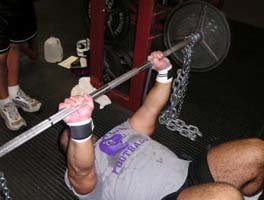
Floor-Press With Chains & Bands.Stable Movement:
- Another thing you can do is pinch in your shoulder blades when performing this exercise. This will create a more stable movement when bench pressing. Keep the pressure on your back and traps... yes that's right bench pressing works your back as well which many do not understand.
Pressing your legs into the ground, elevating your torso and keeping the pressure on your back and traps drives your body into the movement and increasing the support. Push the bar in a straight line, many people push the bar towards the rack a little which is also what can cause tearing pecs putting too much pressure on your pecs.
If you keep the bar near your upper abdominal muscles and push in a straight line and you will have less distance to move the bar. If you move it towards the rack it may go a few inches in distance, but with a straight line you have a shorter distance to go. Keep the elbows tucked in and under the wrists.
This helps keep the bar going in a straight line. Bring the bar towards your upper abdominal muscles. I have said this many times, it prevents injuries and helps improve the lift. One reason why powerlifters have big guts is because we use them to improve our lifts.
By simply filling the abdominal cavity with air we create more stability. Squeeze and try to pull the bar apart, this works the triceps harder through the movement and pushes them harder.
 The Squat:
The Squat:- Many people squat using their quadriceps as the main muscle worked through the movement of the squat. I use a different technique to improve my squat max instead. I get a wide stance of about a few feet. More then just shoulder width, more like twice your shoulder width.
This creates more pressure to the hips and hamstrings and allows you to complete a full squat with less effort then a closer stance. This will also work the quadriceps less. Get a good arch in your back too; pinch your shoulder blades together to prevent any rounding of your back preventing injuries that may occur.
Keep your knees flared out and apply pressure to the outside of your feet. Make sure to get a good flat sole shoe, not the new Nike's, but the classic Chuck Taylor's; they are flat soled and reliable. Keep your head up, if you lower your head, guess were the weight is going? Your body always follows were your head is going.
Move the hips before the knees, this helps you squat straight down in a solid straight line. Fill your abdominal cavity with air again in this movement. Take your belt and put it a notch less then tight, and press your gut into it. Don't fill your chest with air, but your abdominal. This will support the lift with a bigger base.
Now... let's move to how you could add the three lifts into your program while gaining muscle and increasing your strength. I would keep it simple with a common split used with the best exercises known.

The Workout
 Monday: Squat Day
Monday: Squat Day- Squat: 5 sets to 3-5 reps (failure)
- Lunges: 3-4 sets 8-10 reps
- Glute-Ham Raises: 3-4 sets 6-10 reps
- Calf Raises: 3 sets 15 reps
 Wednesday: Bench Day
Wednesday: Bench Day- Bench Press: 5 sets to 3-5 reps (failure)
- Incline Dumbbell Press: 3-4 sets 8-10 reps
- Close-Grip Press: 3-4 sets 6-10 reps
- Crunches: 5 sets 25 reps
 Friday: Deadlift Day
Friday: Deadlift Day- Chin-ups: 3 sets 8-10 reps
- Deadlift: 5 sets to 3-5 reps (failure)
- Bent-Rows: 3 sets 6-10 reps
- Barbell Curls: 3-4 sets 8-10 reps
- Grip Work
- Crunches: 5 sets 25 reps
A basic workout like that would be good for building mass and building strength for the three big lifts. I feel the three big lifts should never be left alone and always used to their potential with a high weight and good form. The form explained earlier in the article will prevent injury.
A lot of guy's injure themselves and blame it on the exercise and not fully understanding the correct form. I hope all of you incorporate the three big lifts into your programs for strength training and whatever the hell else you want to feel the improvements of "more" muscle growth.

Bonus Question
I feel the bench press is the only one that could be replaced from a bodybuilder's standpoint. I feel the deadlift and squat are great for building mass and strength. They should always be incorporated into a workout.
